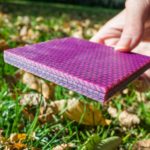News, This Conch-Shell Inspired Material Could Make Helmets and Body Armor Safer
The animal and plant worlds have inspired scientists for ages, and scientists have long been interested in why certain organisms are resilient to impact. Think of a woodpecker’s skull and beak, the protective way a fish’s scales overlap, or the thick rind that keeps a falling fruit from breaking open. One superstar in this field is the queen conch shell, the kind you may have held to your ear to hear the ocean. The queen conch gets beat up by waves and predators, but the structure of the material that makes up its shell is remarkably strong. This is due to the structure of the shell, which features criss-crossed calcium carbonate layers laid out in different orientations and separated by softer proteins, explains MIT engineering professor Markus Buehler, whose lab designed a man-made replica of this structure that could be used in helmets and other protective armor and published the results in the journal Advanced Materials. In both the conch and the man-made version, the “grain” of the material alternates by 90 degrees, so that impact from any particular direction is unlikely to wend its way through.
Learn about our two Decals!
 Click here to find out more about our Fall Bioinspired Design Decal and our Spring Bioinspired Design in Action Decal – ALL MAJORS are welcome.
Click here to find out more about our Fall Bioinspired Design Decal and our Spring Bioinspired Design in Action Decal – ALL MAJORS are welcome.Berkeley BioDesign Community
 Click here to learn about the BioD: Bio-Inspired Design @ Berkeley student organization or here to signup for more info.
Click here to learn about the BioD: Bio-Inspired Design @ Berkeley student organization or here to signup for more info.Search
Student Login





I imagine that the neurological circuits underlying these processes are governed by both 2d spacing maps with their brains as…
to reduce the impact of car accidents, it may be possible to study the force diverting physics of cockroaches to…
you see this type of head-bobbing stability in many avian creatures related to pigeons like chickens. the head ability to…
not like they taught horses how to run! this is an example of convergent evolution where both sea creatures and…
The brain functions in a similar way with neuronal connections. our brains are able to utilize the multiplicity of connections…